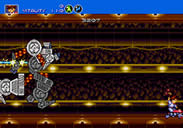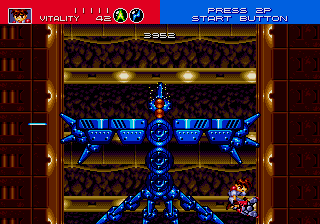Introduction
 Like
most every game made by the development house Treasure, Gunstar
Heroes is an absolutely
relentless action game. The action only lets up for a surprising
(and completely unnecessary) amount of plot in-between levels.
I've always been a fan of the Bad Dudes approach to action
game storylines. "Ninjas have kidnapped the President.
Are you bad enough?!" Do action games really need much
plot? Ahh..... I remember the days of Contra, where you didn't
even know the game had a plot unless you beat it. Gunstar
Heroes has a number of characters both good and bad that reappear
throughout the game. Maybe I'm not geeky enough, but I just
don't want to get into the plot. Gunstar Heroes is not about
plot! It's about killing people, blowing things up, and the
very Japanese weirdness that is the calling card of all Treasure
games. Like
most every game made by the development house Treasure, Gunstar
Heroes is an absolutely
relentless action game. The action only lets up for a surprising
(and completely unnecessary) amount of plot in-between levels.
I've always been a fan of the Bad Dudes approach to action
game storylines. "Ninjas have kidnapped the President.
Are you bad enough?!" Do action games really need much
plot? Ahh..... I remember the days of Contra, where you didn't
even know the game had a plot unless you beat it. Gunstar
Heroes has a number of characters both good and bad that reappear
throughout the game. Maybe I'm not geeky enough, but I just
don't want to get into the plot. Gunstar Heroes is not about
plot! It's about killing people, blowing things up, and the
very Japanese weirdness that is the calling card of all Treasure
games.
Gameplay
The play control has a lot of the features you would expect
from a game of this type, but also a lot of surprises. Before
you begin your game you are given the choice of "free
shot" or "fixed shot". The free shot option
allows you to run and fire at the same time and is often preferable
in open level situations. With the fixed shot option you cannot
run while firing, but the ability to stand still and fire
in any direction is a huge help when fighting bosses. I personally
can't imagine anyone playing this game for long and still
choosing the free shot option every game.
Another
neat addition to Gunstar Heroes is hand to hand combat. You
can throw enemies, and slide into them by pressing down and
jump. There is also a super slide that can be executed by
rotating the control pad like you would to throw a fireball
if you were playing as Ryu or Ken in Street Fighter II. Enemies
can also be kicked in mid air by pressing the jump button
again. This can cause a lot of damage, and can be extremely
helpful against some bosses. If you are playing with two players
either player can throw their partner at enemies which causes
massive damage. Some bosses can be defeated in three or four
hits this way.
Note:
For those of you that are curious, the FAQ's included on this
site get a little more into the characters and game plot.
THE
GRAPHICS
 |
The
programmers of Gunstar Heroes went way out of their way and
included dozens of graphical effects that had never been seen
on the Genesis. Bosses rotate, backgrounds warp and shift,
and the intro includes a polygonal Treasure Logo. No other
game on the Genesis pushed the system this far. In fact, nothing
on the Super Nintendo scaled objects as well, or moved this
fast or smoothly with the possible exception of a few Super
FX chip games. Gunstar Heroes draws a lot of comparisons to
Neo Geo games like Metal Slug. Although the Genesis hardware
is obviously inferior to the Neo Geo, you wouldn't know it
by playing Gunstar Heroes. Much like Metal Slug the bosses
in Gunstar Heroes are made up of tons of sprites that move
and jiggle independently. As a result the bosses animate better
than anything else you've seen on the system. I don't know
how they do it, but Treasure seems to find a way to get the
most out of any system they program for. The graphics in Gunstar
Heroes are among the best ever to appear on a 16-bit system.
Perhaps I've seen sprites that were more expertly drawn, but
I've never seen a Genesis game that moves like Gunstar Heroes.
Sometimes I've felt that some Treasure games have lacked a
bit in art direction, but from a technical standpoint they
are almost always groundbreaking.
 THE
WEAPONS THE
WEAPONS
One of the most inventive aspects of Gunstar Heroes is the
weapons system. There are four different type of weapons:
fire, lightning, homing, and machine gun. Much like other
games in the genre (Contra / Metal Slug) the weapon you are
using plays a large role in your success. What makes Gunstar
Heroes different from other games is that you have two weapon
icons at the top of your screen. Every weapon on it's own
behaves as you would expect, but is quite weak. The fire weapon
is a flame thrower that causes a lot of damage, but has short
range, the homing weapon follows enemies, the lightning or
laser gun fires in a straight line, and the machine gun causes
lots of damage. In Gunstar Heroes you can mix and match the
weapons. If you load yourself up with a fire and a homing
gun you can select each individually, or you can use them
together. The result will be a flame thrower that seeks the
enemy. Mixing the machine gun and the fire will give you projectiles
that explode in flames upon impact. If you combine two of
the same weapon you end up with a more powerful weapon. The
machine gun causes more damage, and the flame thrower has
a much longer range. My personal favorites are the double
flame thrower or the flame/machine gun combination. Everyone
has their own preferences, and I would encourage anyone to
find out what they enjoy the most for themselves. There are
weapon combinations that may make some levels seem too easy.
It may be best to choose a favorite combination that maintains
the fun and challenge of the game instead of a combo that
makes the level a breeze.
THE
LEVELS
The levels in Gunstar Heroes are surprisingly varied and nonlinear
for the genre. There are a total of 7 levels and the first
four can be played in any order, although it is advisable
to play them from left to right because the difficulty increases
and you are rewarded with more health each time you beat a
level. The first of the original four levels is a standard
run an shoot level. If you've played any number of games in
the genre you will know what to expect here. The second level
is a bit different. It takes place in mine shafts and the
players can attach their mine carts to the ground or the ceiling.
The mine shaft flies by at dizzying speeds and occasionally
changes directions scrolling both vertically and horizontally.
The third level is more of a standard shooter level with both
vertical and horizontal scrolling. This level features some
really nice special effects and really gives the player the
feeling of speed and height. The last of the original four
levels is really different. It is a series of challenges and
battles laid out in board game format. The player rolls a
set of dice and then advances to the next challenge. This
level can vary greatly in challenge depending on which squares
you land on.
 |
After
the fourth level the game becomes linear, but the action only
picks up. There are three levels left in the game at this
point. The first is another side scrolling level that seems
to go on forever, but don't worry, there is a secret way to
get unlimited health (read an FAQ). Then comes the outer space
shooting level that is quite unlike any other level in the
game. The level plays almost like a cross between Gradius
and Smash TV. You can move and fire in any direction, but
as long as you hold down the fire button, the angle that you
are firing in stays fixed. If you are playing with two players
the cannon and the ship are controlled separately. This is
lots of fun, and one of the reasons that this is such a fun
multiplayer game. The final level is made up of mostly boss
battles. You need to fight every boss once more. This shouldn't
be too much of a problem because by now you should have a
pretty good handle on how do defeat each boss. But don't expect
it to be a total breeze, the bosses will mix up their attacks
a bit. After you've defeated all of your enemies one more
time you will fight the game's final boss. If you have gotten
this far, you should be well prepared. If you are playing
with a friend, hurl your partner and make short work of him.
Note:
For a much more in-depth breakdown of the levels read one
of the FAQ's in the Game Help section of this site, or visit
my favorite game help site gamefaqs.com.
|

